

Project «Voices of Jewish settlements. Vitebsk region.»פיתוח קשרי התרבות בין העמים של ישראל ובלרוס
|
|---|
Website search |
|
MainNew publicationsContactsSite mapVitebsk regionMogilev regionMinsk regionArkady Shulman
|
Arkady SHULMANTHE HOMELAND OF MY DREAMS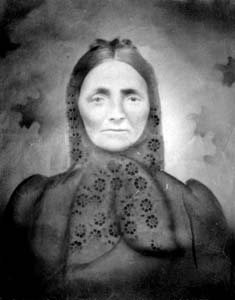
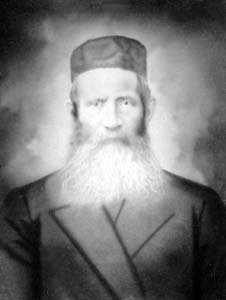 Yevel Nirman and his wife.
Yevel Nirman and his wife.
I received a letter from a man in St. Petersburg, in which he wrote that he was born in Dubrovno. His father died in the local ghetto and the memory of him was troubling him for many years. I wrote a reply the same day, saying I was prepared to meet him in Dubrovno and so we arranged the meeting. I met Yury Arkadievich Nirman in Vitebsk and we headed for Dubrovno. This is what he told me: - Before the war our family lived in Dubrovno. It’s a small town, located on the Dnieper. We used to live in Krylov Street, closer to the left bank of the river. We had a big house and a big family: my parents and four brothers. Elder brother Grisha (born in 1921), then Misha (born in 1925), Gera (born in 1928) and I, born three years before the war began. My father, Aron Yevlevich, was a butcher. He was a physically strong person. Our family was neither rich nor poor. Father worked a lot – he believed that a man should be the breadwinner of the family, it was his responsibility. Before the war my brother Grisha went to work in a printing house. Mother’s name was Genia Nirman (maiden name Polina). All my grandparents lived in Dubrovno. 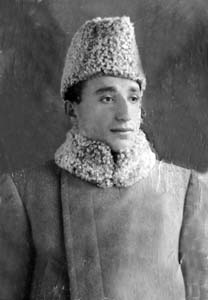 Aron Nirman.
Aron Nirman.
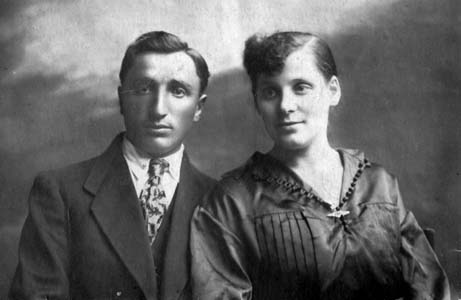 Aron and Genia Nirman.
Aron and Genia Nirman.
Our family adhered to all the Jewish traditions and celebrated all the Jewish holidays. Father attended the synagogue, even though at that time it was not especially favored by the Soviet authorities. The war forced us to leave Dubrovno and destroyed the world we lived in. That world cannot be brought back and remains only in the memories of the old people like me. 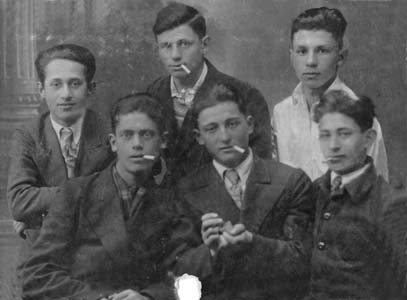 Jewish children from Dubrovno.
Jewish children from Dubrovno.Grisha Nirman – at the top in the center. When we arrived in Dubrovno, we visited an old Jewish cemetery, or, to be more exact, a place where it used to be located once. The cemetery was most probably about three hundred years old. The last Dubrovno Jew, buried here, was Isaac Levertov (he was buried in 1963). After the war there were practically no Jews left in Dubrovno and the cemetery was not looked after. In the end there was a decision to demolish the cemetery and build a stadium for an agricultural lyceum. The lyceum principal offered students to collect the tombs, which were scattered around, and set them up next to a football field. Then a fence was constructed. Thus a memorial to Dubrovno Jews was opened and the lyceum students received a lesson in kindness and humanism. 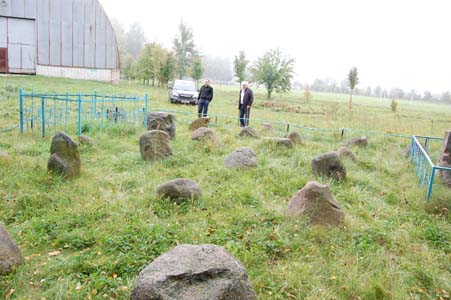 Jewish cemetery on the territory of agricultural lyceum.
Jewish cemetery on the territory of agricultural lyceum.
We reached Krylov Street, where the Nirmans lived before the war. Yury Arkadievich showed me the foundation of his house. He continued his story: “As mother told us, nobody believed that the war was going to be so ruthless and long; everyone was certain that the Red Army was the strongest and that Nazis would not harm the local population. When the war broke out and Germans invaded, father had to join a home guard detachment. The rest of the family was evacuated on July 6th 1941. Father realized he had to do something to save his family and pushed us into one of the trains, which headed eastwards. We were sure that we were leaving only for a short period of time and would soon return to Dubrovno. Mother took only basic things. On the way the train was bombed and many people were killed. We were lucky. Then we got on another train and managed to reach a town of Muchkala in Tambov region. Some local people gave us shelter and we decided to settle there. Mother and brothers earned a living by working on the collective farm. 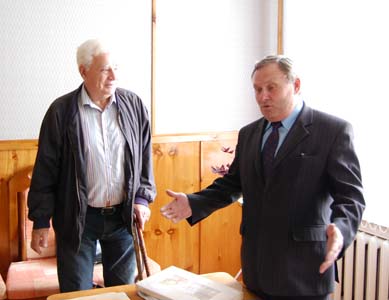 Yury Nirman with Mikhail Yevtushenko, the lyceum principal.
Yury Nirman with Mikhail Yevtushenko, the lyceum principal.
Brother Grisha had to continue working at the printing house – there was a decree, which prohibited people to leave work without permission. Luckily, the very last moment, just before Nazis invaded, father managed to send Grisha to the east. Father was given shelter in our neighbor’s house. She was a kind Belarusian woman. Her name was Avginia. However some time later father, realizing that he was putting her family at risk, decided to leave. That was how he got into the local ghetto. 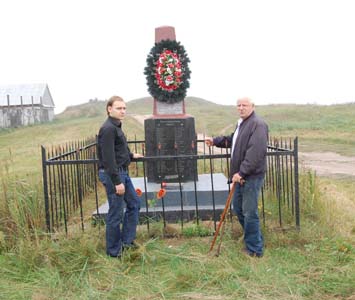 Yury Nirman with nephew Zhenia
Yury Nirman with nephew Zhenianear memorial at the execution site in Dubrovno. In the middle of July 1941 Germans were living in Dubrovno. From the first days of occupation they tortured and humiliated Jews. All the Jews: women, old people, and children were to be killed. No one expected such an end – they hoped for the better. However, their illusions dwindled day by day. On December 6th 1941 fascists executed 1500 ghetto residents. Marfa Vasilievna Zolotarskaya recalled: “Two machine guns were brought to the edge of a ditch. They started bringing families. Children were shot in their mothers’ arms. Then the bodies were thrown into the ditch. Some of them were alive. In the end they brought infants and one German sadist took them one by one and hit them on his knee, breaking their spines. The ground was moving several days after the execution.” “Father was also killed on that day – December 6th, 1941 – told me Yury Arkadievich Nirman. – We learned about it in 1947, when we returned from the evacuation. We did not return to Dubrovno, because our house was no longer there. We moved to Orsha, because mother’s brother lived there and could help us build our own house. We were told that when father was being taken to the execution, he grabbed hold of one of the fascists and dragged him into the ditch. Moreover, they say he managed to bite through his neck. It’s very difficult to imagine.” After the first execution fascists left a group of craftsmen – around 300 people, who had to work for them. These people lived until February 1942. 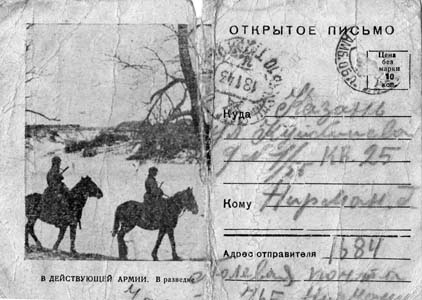 Such postcards were sent by Grigory from the battlefront.
Such postcards were sent by Grigory from the battlefront.
 Grigory Nirman.
Grigory Nirman.
All in all 1985 Jews were murdered in Dubrovno. All the fascists’ actions had been previously planned. The mass executions usually took place on Jewish or Soviet holidays. In this way Nazis wanted the locals to feel that they are doomed and that resistance was useless. At the beginning of the 50s a memorial was set up at the location of the execution. 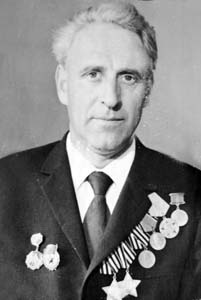 Mikhail Nirman.
Mikhail Nirman.
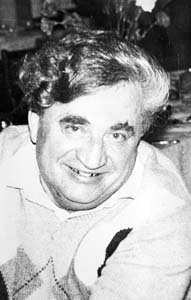 Gera Nirman.
Gera Nirman.
We spent the night in Orsha, in the family of Yury Nirman’s nephew, Mikhail’s son – Arkady. On the walls of his flat we saw numerous family photographs. Naturally, I began asking Yury Arkadievich about his brothers. “Brothers were drafted to the army. Grisha was the first. His eyesight was very bad, so he was sent to a railway detachment. We still have postcards that Grisha sent us from the army, where he wrote: “Dear mother and brothers! I will do everything to revenge the Nazis for our peaceful life that they have destroyed. Grisha was killed in 1943 near Voronezh. Brother Misha was drafted in March 1943. He was wounded and sent to hospital. After the war he spent two years in hospitals in Ulianovsk and Kazan. Later he moved to Orsha and began working. Another brother Gera was a watchmaker. He was handicapped, but always remained optimistic.” Yury Nirman has lived a long life and visited many cities and countries. Here, in Orsha, he wants to be buried at the Jewish cemetery, next to the graves of his relatives. LIST of victims murdered by Nazis in Dubrovno.
|
|||||||||||||||||||||||||||||||||||||||||||||||||||||||||||||||||||||||||||||||||||||||||||||||||||||||||||||||||||||||||||||||||||||||||||||||||||||||||||||||||||||||||||||||||||||||||||||||||||||||||||||||||||||||||||||||||||||||||||||||||||||||||||||||||||||||||||||||||||||||||||||||||||||||||||||||||||||||||||||||||||||||||||||||||||||||||||||||||||||||||||||||||||||||||||||||||||||||||||||||||||||||||||||||||||||||||||||||||||||||||||||||||||||||||||||||||||||||||||||||||||||||||||||||||||||||||||||||||||||||||||||||||||||||||||||||||||||||||||||||||||||||||||||||||||||||||||||||||||||||||||||||||||||||||||||||||||||||||||||||||||||||||||||||||||||||||||||||||||||||||||||||||||||||||||||||||||||||||||||||||||||||||||||||
|
|
Jewish settlements in Vitebsk regionVitebsk • Albrehtovo • Babinovichi • Baran • Bayevo • Begoml • Beshenkovichi • Bocheikovo • Bogushevsk • Borkovichi • Braslav • Bychiha • Chashniki • Disna • Dobromysli • Dokshitsy • Druya • Dubrovno • Glubokoye • Gorodok • Kamen • Kohanovo • Kolyshki • Kopys • Krasnopolie • Kublichi • Lepel • Liady • Liozno • Lukoml • Luzhki • Lyntupy • Miory • Obol • Oboltsy • Orsha • Osintorf • Ostrovno • Parafianovo • Plissa • Polotsk • Prozorki • Senno • Sharkovshina • Shumilino • Sirotino • Slaveni• Smolyany • Surazh • Tolochin • Ulla • Verhnedvinsk • Vidzy • Volyntsy • Yanovichi • Yezerishe • Zhary • Ziabki • |
Main |
New publications |
Contacts |
Site map |
Vitebsk region |
Mogilev region |
Minsk region |